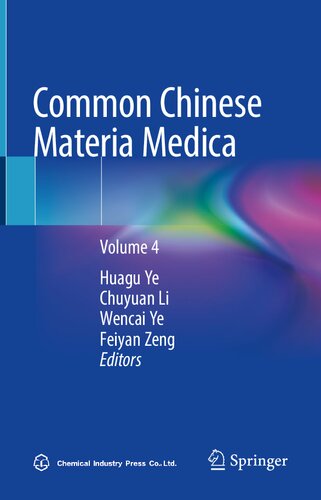Common Chinese Materia Medica: Volume 4 2021
دانلود کتاب پزشکی Materia Medica رایج چینی: جلد 4
| نویسنده |
Chuyuan Li, Feiyan Zeng, Huagu Ye, Wencai Ye |
|---|
| تعداد صفحهها |
621 |
|---|---|
| نوع فایل |
|
| حجم |
77 Mb |
| سال انتشار |
2021 |
89,000 تومان
این جلد چهارم 256 گیاه دارویی از 5 خانواده را توصیف میکند که معمولاً در طب چینی استفاده میشوند. مهم ترین گونه ها عبارتند از: Agrimonia pilosa، Amygdalus persica، Armeniaca mume، Armeniaca vulgaris، Armeniaca sibirica، Chaenomeles sinensis، Eriobotrya japonica از Rosaceae. Chimonanthus praecox از Calycanthaceae. Albizia julibrissin، Archidendron clypearia، Entadaphaseoloides، و Bauhinia championii از Mimosoideae. Caesalpinia sappan، Cassia tora، Gleditsia sinensis of Caesalpiniaceae; Abrus cantoniensis، Astragalus Membranaceus، Astragalus Membranaceus، Dalbergia odorifera، Desmodium caudatum، Desmodium Styracifolium، Erythrina variegata، Euchresta japonica، Flemingia prostrata، Glycyrrhiza uralensis، روش های توزیع علمی، Glycyrrhi، گونه های علمی پراکنش، Glycyrrhi تهیه و فرآوری این گیاهان دارویی، محتوای خواص دارویی، اثرات درمانی، استفاده از این گیاهان دارویی و دوز مصرفی آنها و ضمیمه عکس های رنگی ویرایش نشده و تصاویر قسمت هایی از داروی گیاهی برای هر نوع.
این مجموعه کتاب در مجموع دارای 10 جلد است که بیش از 2000 نوع داروی رایج چینی را پوشش می دهد. این مجلدات نه تنها عملکرد اثربخشی و برخی نسخههای داروها، بلکه ویژگیهای بیولوژیکی آنها را با تصاویر واضحی از زیستگاهها به تفصیل ارائه میدهند تا خوانندگان بتوانند آنها را در میدان شناسایی کنند. جدا از محیط رو به رشد، کتاب ها مناطق توزیع و سایر اطلاعات را برای تسهیل تحقیق و سایر کاربردها توضیح می دهند. این مجلدات برای خوانندگان مورد علاقه عمومی است و برای محققان و مربیان ارزش مرجع بالایی دارد. این می تواند به عنوان یک راهنما برای محققان، پزشکان و دانشجویان در گروه پزشکی و طب سنتی چینی استفاده شود.
This fourth volume describes 256 species of medicinal plants from 5 families, which are commonly used in Chinese medicine. The most important species are Agrimonia pilosa, Amygdalus persica, Armeniaca mume, Armeniaca vulgaris, Armeniaca sibirica, Chaenomeles sinensis, Eriobotrya japonica of Rosaceae; Chimonanthus praecox of Calycanthaceae;Albizia julibrissin, Archidendron clypearia, Entada phaseoloides, Bauhinia championii of Mimosoideae; Caesalpinia sappan, Cassia tora, Gleditsia sinensis of Caesalpiniaceae; Abrus cantoniensis, Astragalus membranaceus, Astragalus membranaceus, Dalbergia odorifera, Desmodium caudatum, Desmodium styracifolium, Erythrina variegata, Euchresta japonica, Flemingia prostrata, Glycyrrhiza uralensis, Glycyrrhiza inflata, Glycyrrhiza glabra, Lablab purpureus, Sophora japonica and Spatholobus suberectus of Butterflyaceae.
In each specie, it introduces the scientific names, medicinal names, morphologies, habitats, distributions, acquisition and processing methods of these medicinal plants, the content of medicinal properties, therapeutic effects, usage and dosage of these medicinal plants, and attaches unedited color pictures and pictures of part herbal medicines of each species.
This book series has 10 volumes in total, which covers over 2000 kinds of Chinese medicines that are commonly used. These volumes not only introduce the efficacy function and some prescriptions of the medicines, but also introduce the biological characteristics of them in detail with clear photos of the habitats, so that readers can identify them in the field. Apart from the growing environment, the books expound the distribution areas and other information to facilitate researches and other applications. The volumes are targeted at readers of general interests and it is also of high referential value for scientific researcher and teachers. It can be used as a guide to researchers, clinical doctors, and students in the department of pharmaceutics and traditional Chinese medicine.




